How to Paint Furniture with Chalk Paint
Ready to give your tired old furniture a fresh new look? We’ve got just the thing for you – chalk paint! It’s like magic in a can, transforming even the dullest pieces into a brand new masterpiece. In our latest blog post, how to paint furniture with chalk paint, we’re sharing all the tips and tricks you need to know to start chalk painting your furniture.
From prepping your furniture to creating professional look, we’ve got you covered. So grab your brushes and get ready to create some serious furniture envy!
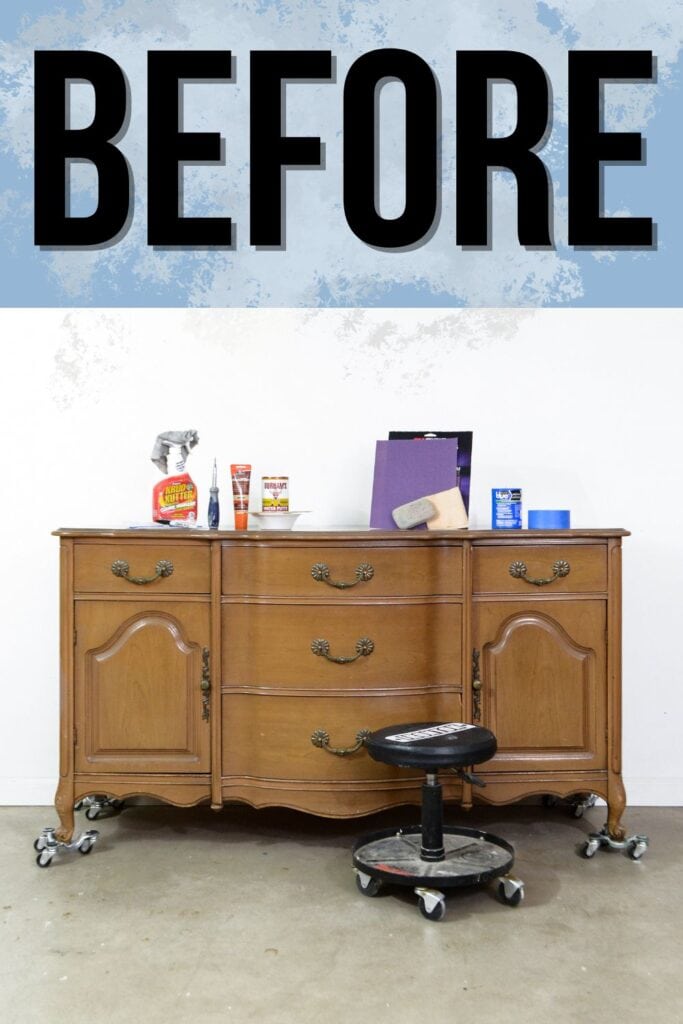
Painting furniture is a great way to give your old pieces of furniture a fresh new look. Chalk paint is one of the most popular types of paint for furniture projects because it’s easy to use and doesn’t require any sanding or priming prior to application.
In this blog post, we’ll cover everything you need to know about using chalk paint for furniture, including painting techniques, distressing options, and sealing the paint to create a professional finish.
No matter your skill level or budget, you’ll be able to give new life to your furniture with chalk paint. So let’s get started!
Another great resource is these five biggest furniture painting mistakes you need to avoid!
Supplies to Paint Furniture with Chalk Paint
As an Amazon Associate, I earn from qualifying purchases. I also may earn from other qualifying purchases with other companies or get free product to review and use. All opinions are my own.
Here is a list of the tools and supplies that we used for painting this wooden buffet. You may need all of these or just a couple of them for your project. No matter, for your reference, these are what we use when painting furniture with chalk paint.
- Screw Driver
- Krud Kutter and a Damp Rag
- Wood Filler
- 220 Grit Sandpaper
- Tack Cloth
- Painters Tape
- Paint Brush
- Primer (for very slick and shiny surfaces)
- Chalk Paint
- Paint Sprayer
- Painting Sponge
- Varathane Polyurethane
Get my list of the 10 best Painting Furniture Furniture Supplies.
Before Painting Furniture with Chalk Paint
Most furniture will have hardware. Everything needs to be removed for a clean paint finish. If you want to change out the hardware, here is How to Change Hardware on Furniture so you can get some updated hardware.
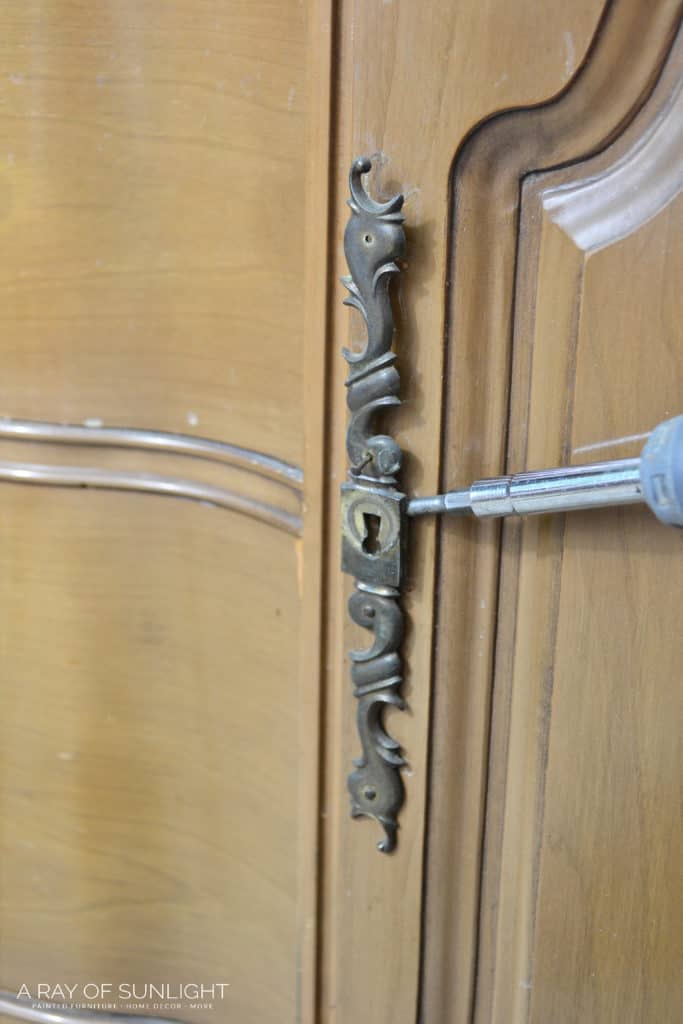
What does dust, dirt, oil, wax and grime have in common?? They mess up your paint! So we need to get them removed before we go any further.
So grab some Krud Kutter. This stuff is so amazing that I use it on every furniture makeover. Then let your furniture dry.
Learn more about How to Clean Furniture Before Painting here.
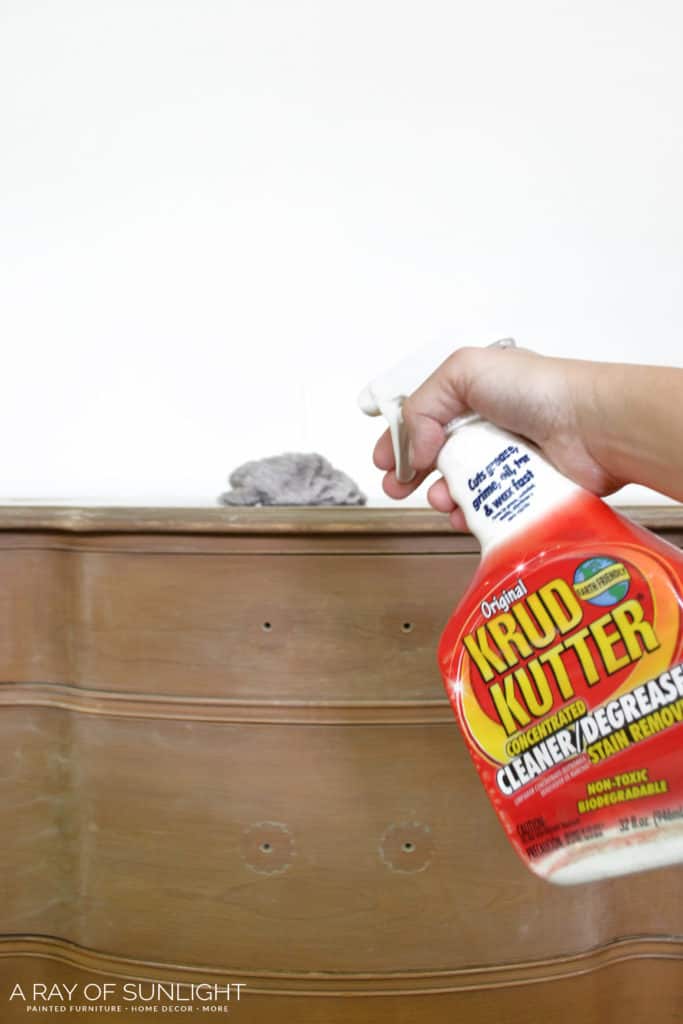
The next step in furniture painting is to fill in any imperfections that you don’t want to show anymore. I use this wood filler to fill the small scratches.
Wood fillers aren’t all made the same though, some are for small scratches, while others are best for large chunks of missing wood.
Here is my list of the best wood fillers for furniture to help you know which one is best for your project.
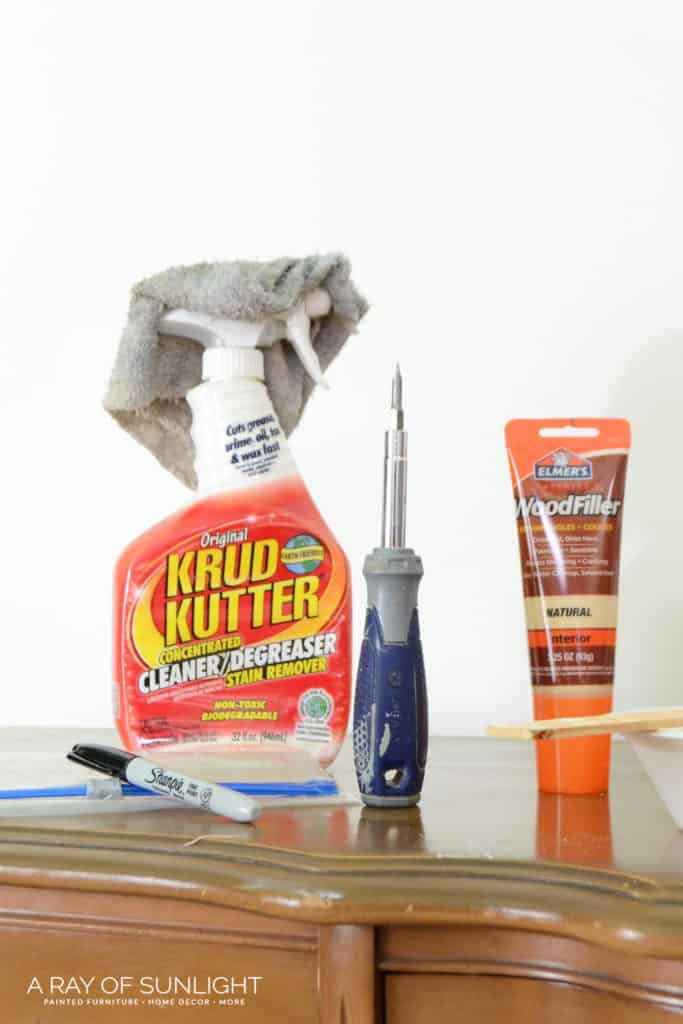
For smaller scratches, be generous with the wood filler and fill the damage completely.
Learn how to repair damaged furniture with Bondo in this post. Check out my Bondo wood filler review to learn more.
Get the Secrets!
Grab this super convenient How to Repair Furniture Ebook with all of our secrets on how to repair furniture for only $14.
You can print it out and have instant access whenever you come across damaged furniture, and know exactly how to fix it!
Click on the picture of the book to purchase!
How to Make Paint Stick to Furniture
If you skip over one step, please don’t skip over this one. This is the most important step in making sure that your paint will actually stick to your furniture.
You can scuff sand or use a mixture of both scuff sanding and adhesive primer for this step. If you feel like skipping the sanding step, you need to read our post on the importance of sanding before painting furniture first so you know what you are in for.
Scuff sanding is a light sanding with 220 grit sandpaper that really only takes a few minutes. The goal is to make the old finish a bit rough so the new paint has something to hold on to.
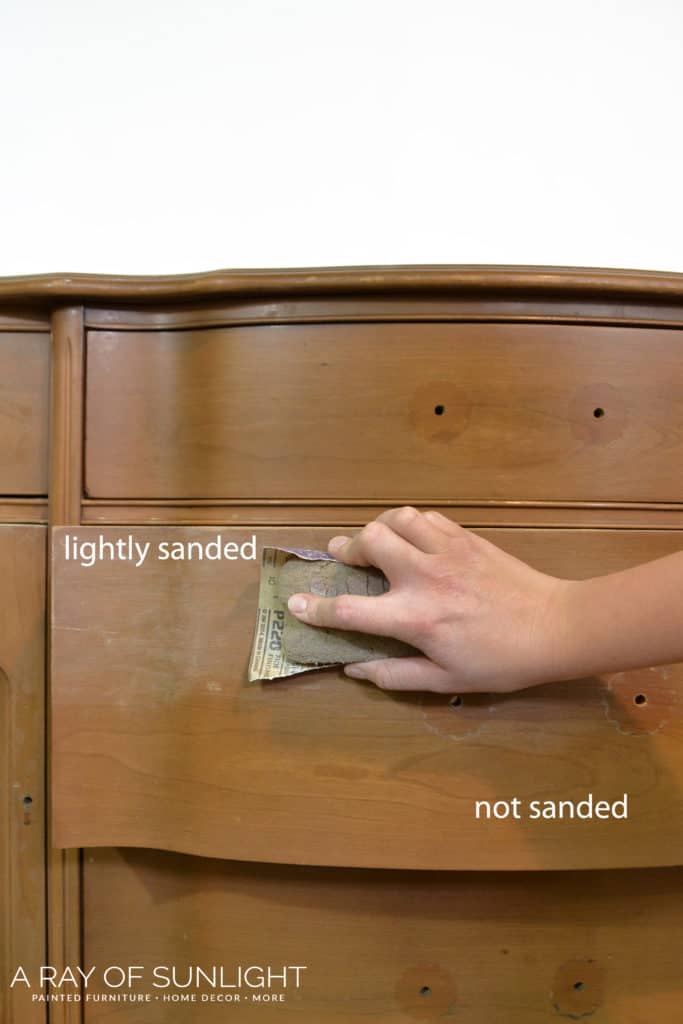
Just grab 220 grit sandpaper and lightly sand everything down. Just a couple of passes over everything should do.
Once you’ve sanded everywhere, you’ll want to remove the dust. I like to use a shop vacuum with a brush attachment to get most of the dust off, and then wipe everything down with a tack cloth to get all of the dust off.
If dust is left behind, the paint will look at feel gritty where the dust is left under the paint.
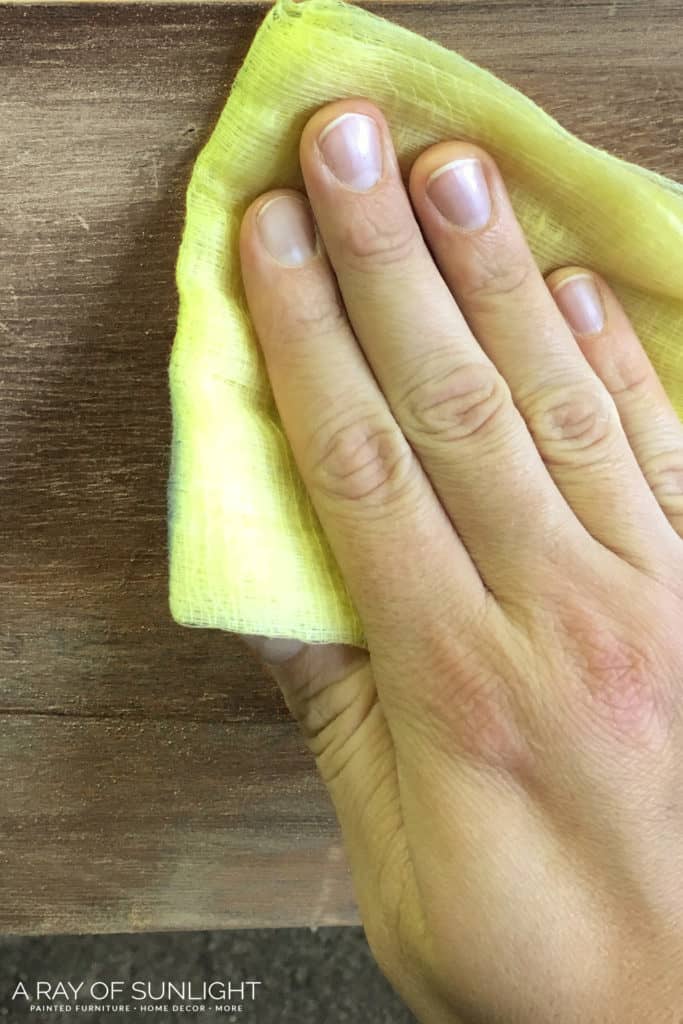
Priming Before Painting Furniture
If the old finish on your furniture is super slick and shiny you really need to prime your furniture after you scuff sand.
This BIN shellac primer is the best! Learn more about the best primers for painting furniture if you aren’t sure if BIN shellac primer is what you want to use.
There are a few really good primers out there you can choose from. You can also check out my list of the best water based primers for more information.
Either way, give your furniture one or two coats of primer, letting it dry between coats.
Not only does the primer help the paint stick to the wood surface, the primer will also stop stains from coming through paint, which is a common occurrence with water based paints.
You can also check out the best spray primer for wood you can use for your wood furniture here.
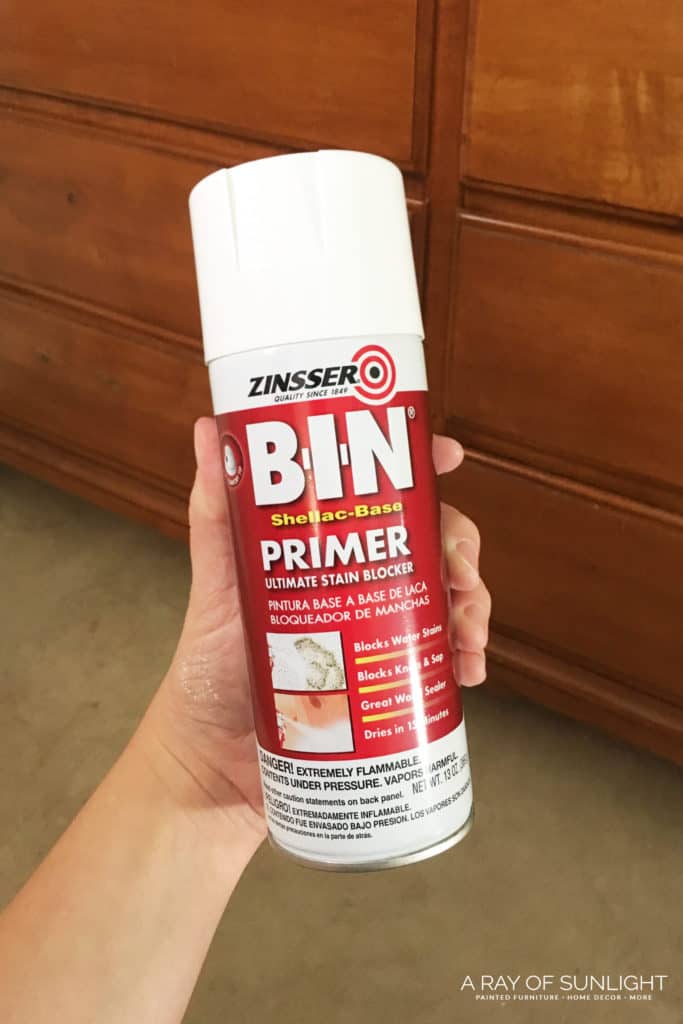
Chalk paint usually “doesn’t require a primer,” and most say that you don’t need to sand either. Both are true to some degree.
Chalk and clay based paints are super flat, and they have an additive in them that helps them stick to a lot of surfaces.
They usually won’t stick to super slick or shiny surfaces on their own though. My favorite brand of chalk paint is Country Chic Paint.
It sticks very well, is easy to use, and they have so many good colors. Their customer service is amazing, and they are also super environmentally friendly! Check out my honest and detailed Country Chic Paint review here.
But, even chalk paint struggles to stick to all furniture surfaces, so if you want your chalk paint to stick really well, it’s best to prime before painting old furniture with chalk paint.
The best part about chalk or clay based paints is how well it distresses.
Latex paint doesn’t like to distress, it just gums up. So if you’re looking for a worn feel, chalk paint is the way to go.
You can also make homemade chalk paint with latex paint if you’re on a budget. Here are chalk paint recipes you can follow for future projects.
Check out this post if you’re curious about what is chalk paint exactly.
How to Paint Furniture with Chalk Paint
When painting furniture, you can either brush, roll or spray the paint on. Either way, thin coats are always better than thick coats of paint.
I also personally like to add some water to the chalk paint to thin it out a little. The water helps you paint furniture without brush marks, and it helps the paint to go on in thinner coats, which is better for adhesion.
Be sure to let the paint dry completely before painting another coat. Most paint needs at least 2 coats of paint for full coverage.
Light colors need 3-4 or even 5 coats sometimes to get full coverage. That’s just the way it is with light colors. But a white primer can be one or two of those coats of paint!
How to Paint Furniture with a Brush
Brushing is pretty straight forward. A nicer brush (like this Country Chic Paint Oval Paint Brush) will also help eliminate brush marks.
I also love Zibra Paint brushes because their brushes are in different shapes. Their round brush is my favorite brush to help get into details on furniture. Their square and triangle brush are amazing as well!
Read through this post to learn more about the best paint brushes for painting furniture and choose the right one for you and your project!
How to Spray Paint Furniture (My favorite way!)
If you have a large project(s), don’t want brush marks, or want to get the painting done quickly, use a paint sprayer!
Check out the difference between spray paint VS brush paint furniture here to help you decide if you want to use a paint brush or a paint sprayer when chalk painting furniture.
This paint sprayer
- doesn’t need an air compressor
- easy to set up and clean up
- you can put any paint in it
- I even use it for my topcoats
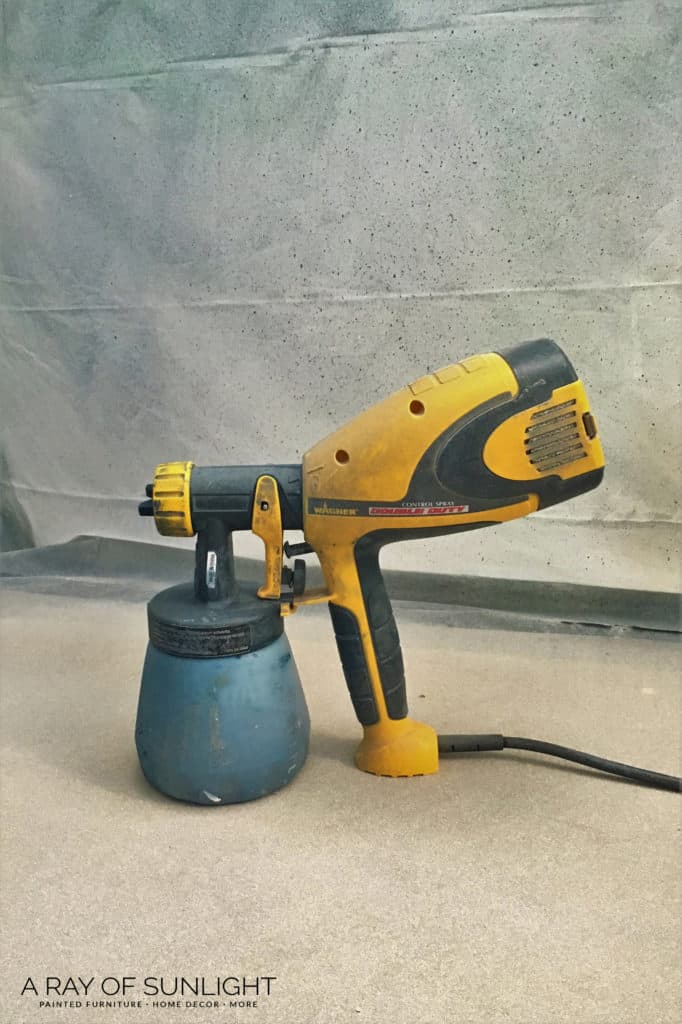
Painting is so fast with a paint sprayer, and it doesn’t leave brush marks! So it’s my go to.
If you want more details on the best (budget-friendly) paint sprayers for furniture, head over to this post on the best HVLP paint sprayers. And learn how to use a paint sprayer like the Wagner Double Duty Paint Sprayer here.
No matter your method of painting, you’ll want to paint at least 2 coats of paint for complete coverage.
How To Distress Painted Furniture
If you’re wanting a worn farmhouse or shabby chic look, you’ll want to distress the edges of your finish just a bit.There are a few ways to distress painted furniture, but my favorite is to use 220 grit sandpaper.
Just make sure the paint is fully dry, and then lightly rub the sandpaper over the edges of the furniture.
Here are 6 techniques for distressing furniture if you don’t want to use sandpaper and get dust all over! And check out distressed painted furniture here for more ideas if you love the look of distressed furniture.
Sealing The Paint with Polyurethane
Finally, you’re onto the last step in painting! This one is very crucial, especially when you’re using chalk paint or mineral type paint.
Chalk paint or clay based paint is super porous and will attract dust like none other. It also isn’t very easy to wipe down if something gets on it. So we always topcoat chalk paint with Varathane Polyurethane Interior in Satin.
Learn more about sealing painted furniture and what sealant to use for different types of paint.
This poly is the best! It is sooo durable, it doesn’t yellow, and it makes the finish feel super professional and smooth.
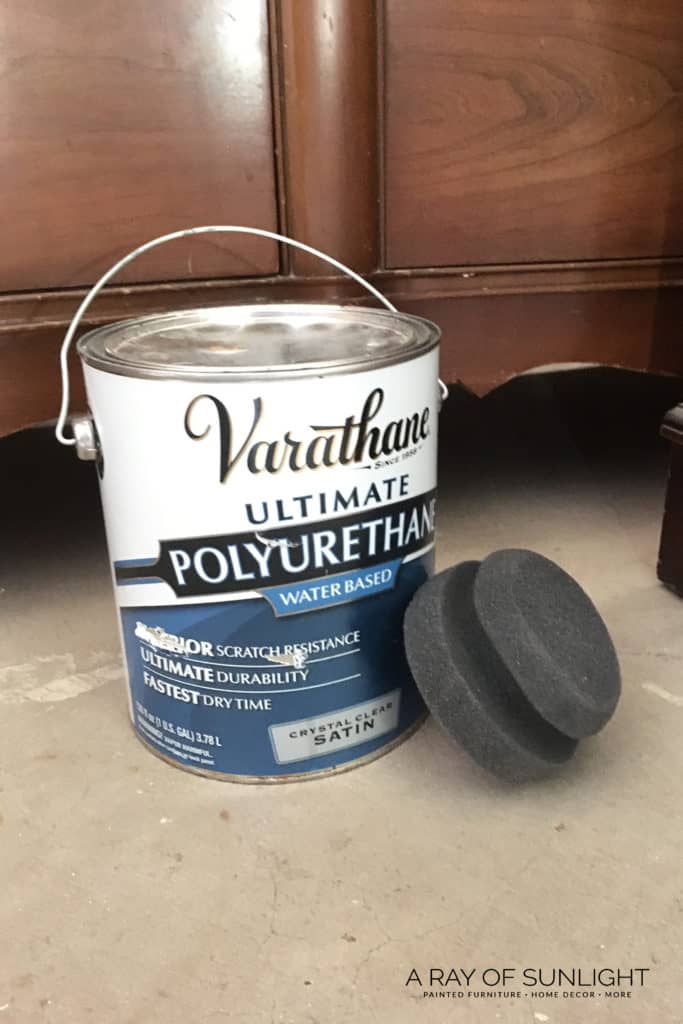
I’ve found that using a sponge like this really helps the application go on smooth and better than a brush! But here’s all the information you need to learn how to apply polycrylic to painted furniture with a sponge or a paint brush.
But I personally like to spray the polyurethane especially when topcoating dark colors of chalk paint. Learn ALL of my tips and tricks on How to Spray Polyurethane with a paint sprayer here!
3 coats of poly is recommended for the best durability, but is super important on high traffic surfaces like dressers, tables and cabinets.
Check out my comparison between polycrylic vs polyurethane to learn about which topcoat is right for your project. Oh, and if you’ve heard of using wax when chalk painting furniture, read our Wax VS Polyurethane to learn why I prefer polyurethane instead of wax.
Now that you’ve learned how to paint furniture, you’re ready to rock! Your old ugly or outdated furniture is going to look so good painted!
Here is what the buffet looks like now that it has a beautiful navy blue chalk painted finish on it! We reused the old hardware and just updated it with gold paint. If you want to paint your hardware, here is how to paint drawer pulls.
Learn more about the finishing touches of painting furniture here.
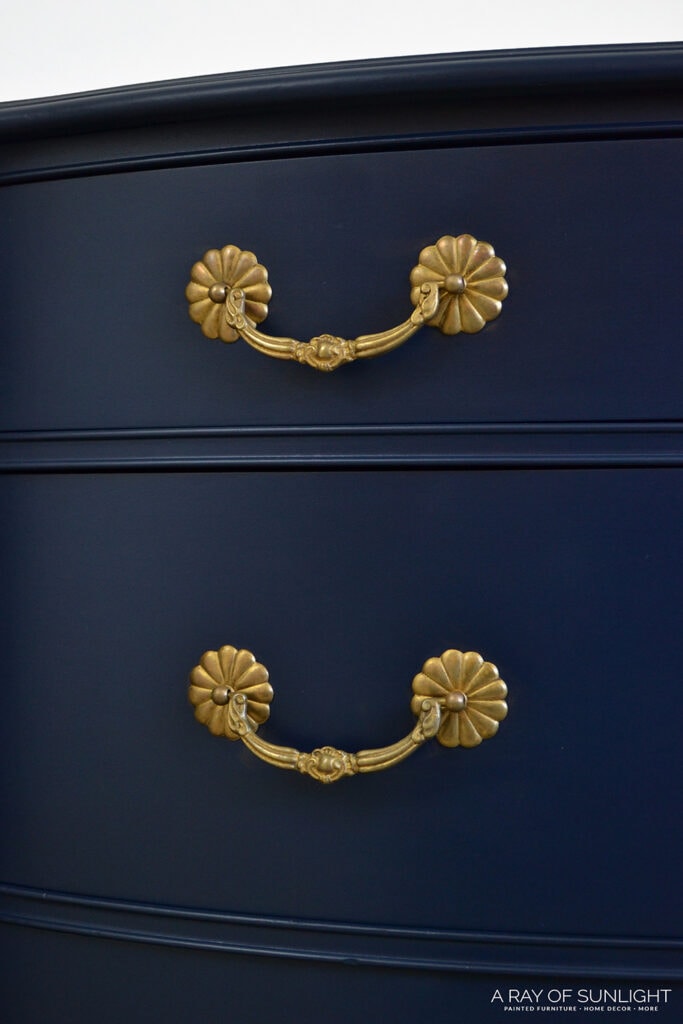
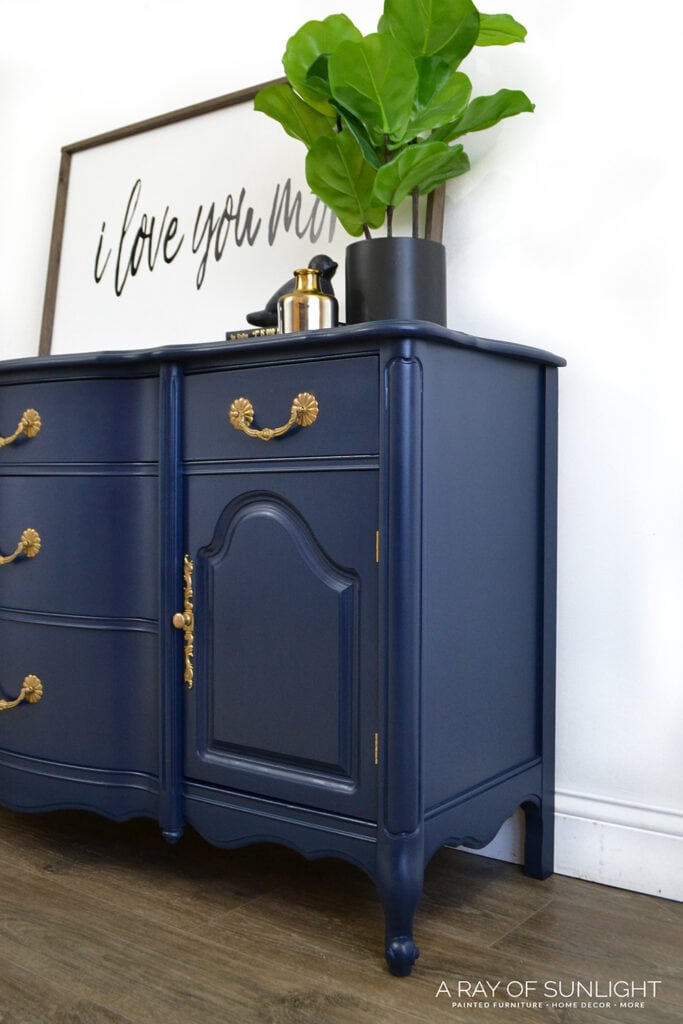

More Before And After Makeovers
Click any of these “before” photos below to view the “after” of that makeover.
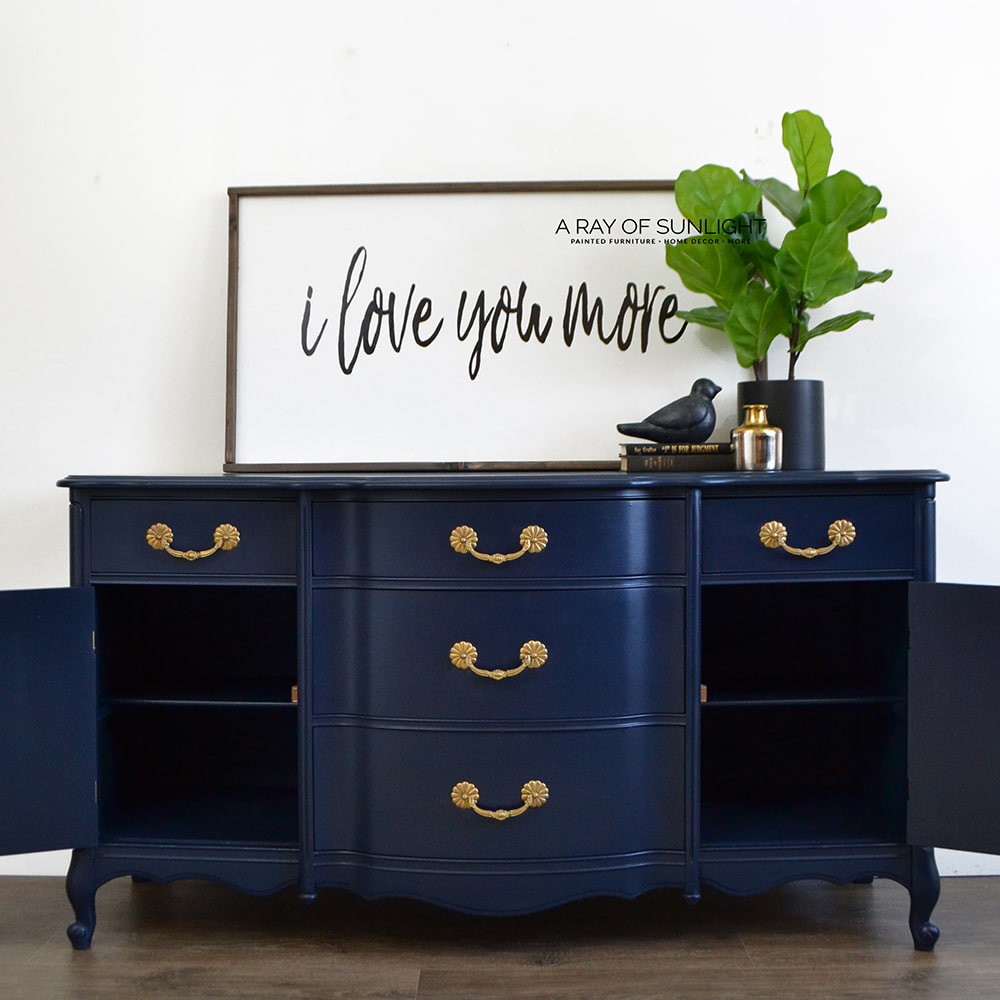
Get more furniture makeover ideas here!
More Painting Furniture Resources
- What Paint to Use on a Dresser
- How to Paint Laminate Furniture
- Painting Furniture with Latex Paint
- How to Chalk Paint Furniture White
- How to Paint Wooden Furniture
Follow us on YouTube to get more tips for painting furniture.
Or share your project with us on our Facebook Group and be part of our community. See you there!



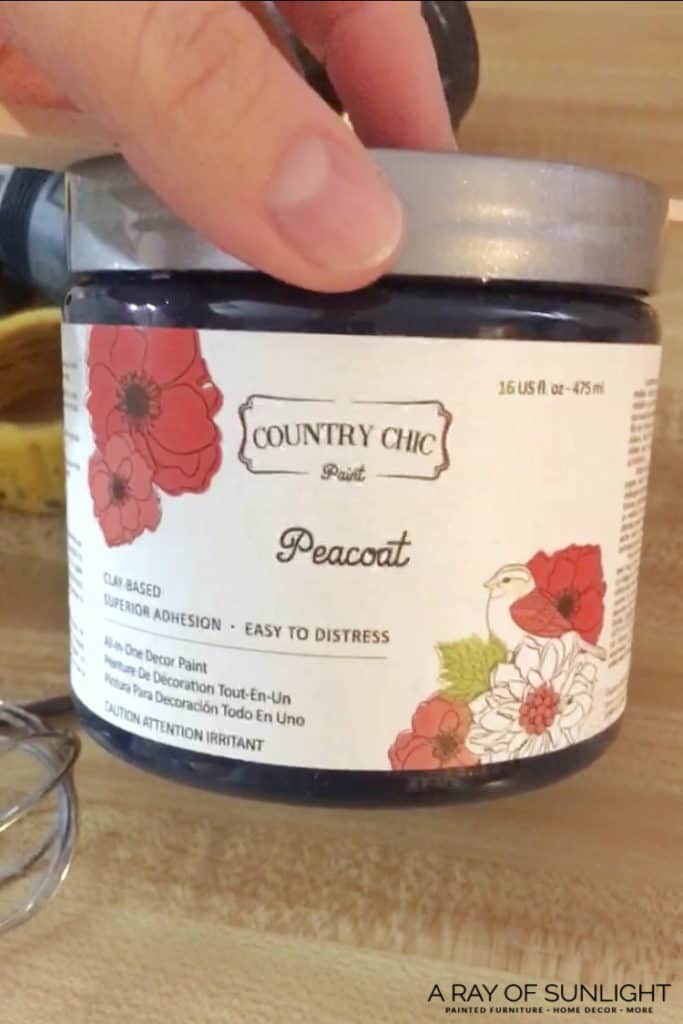
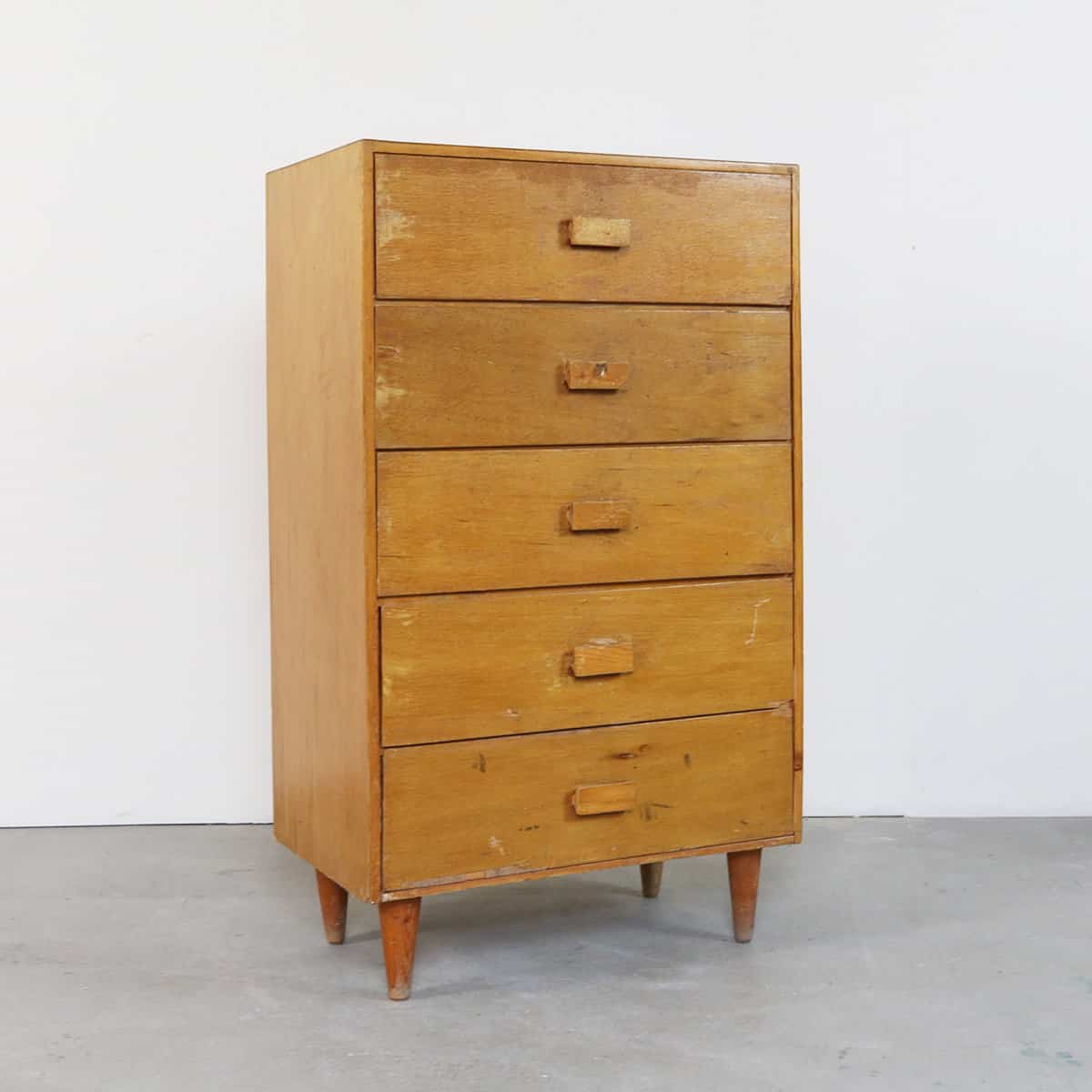
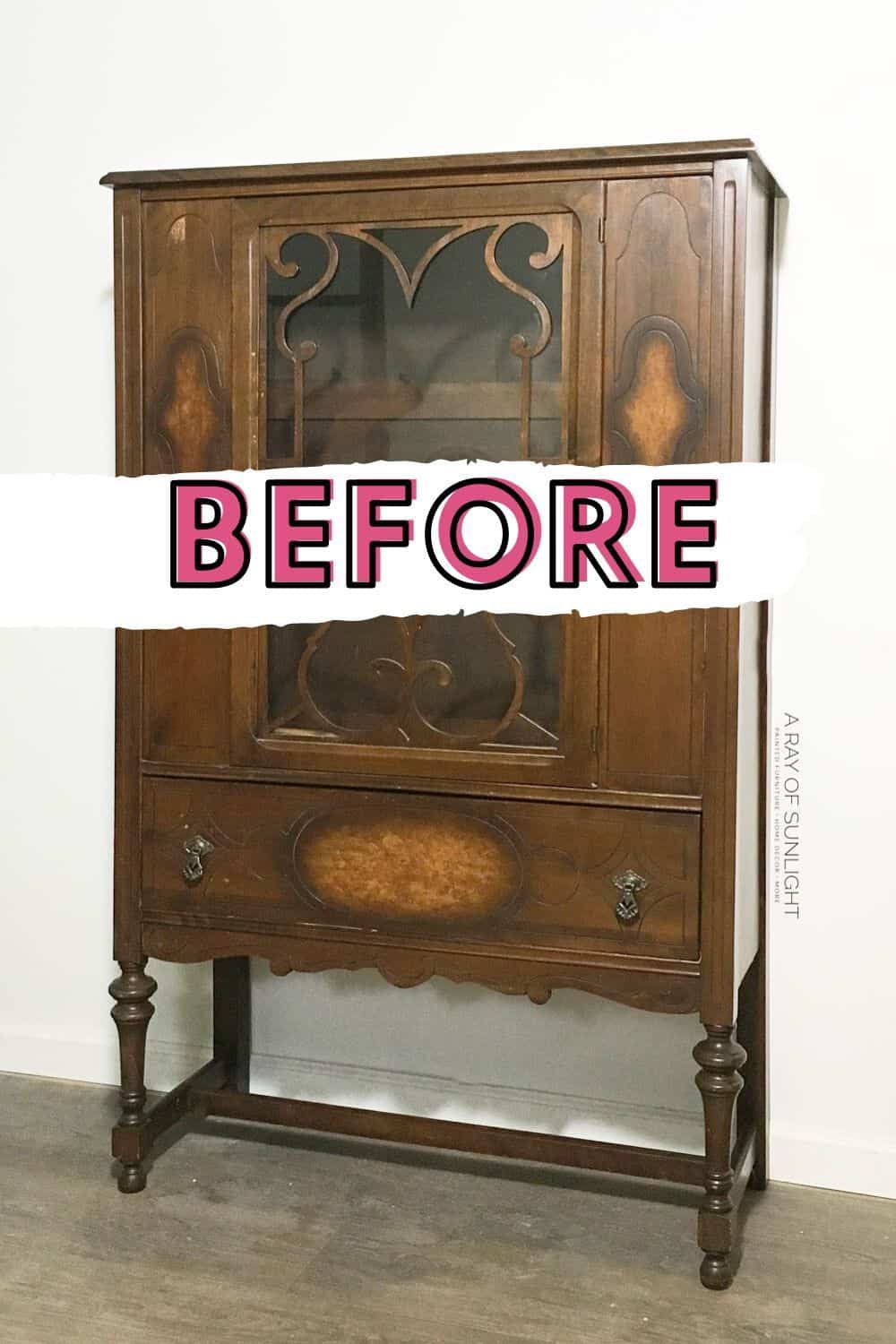
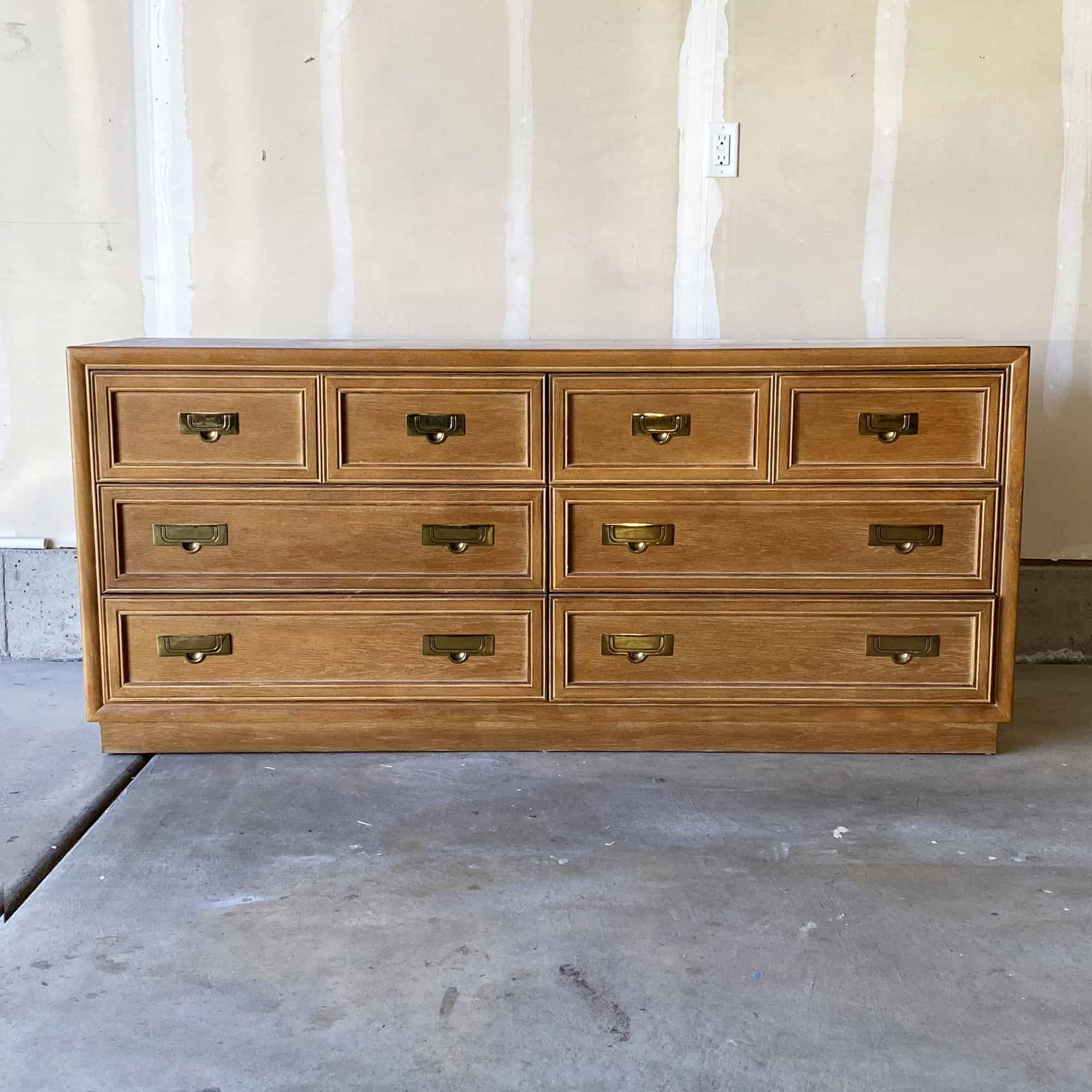
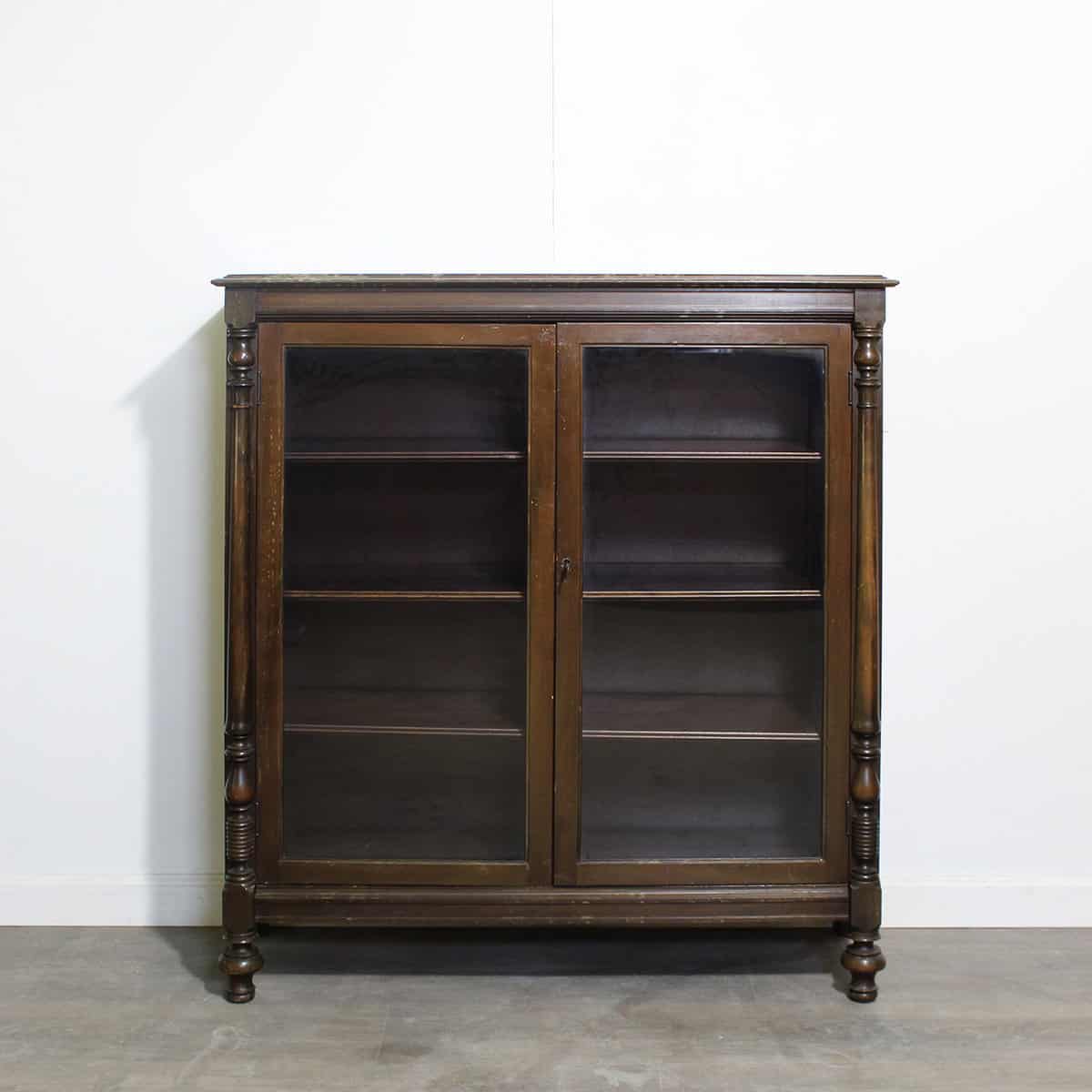
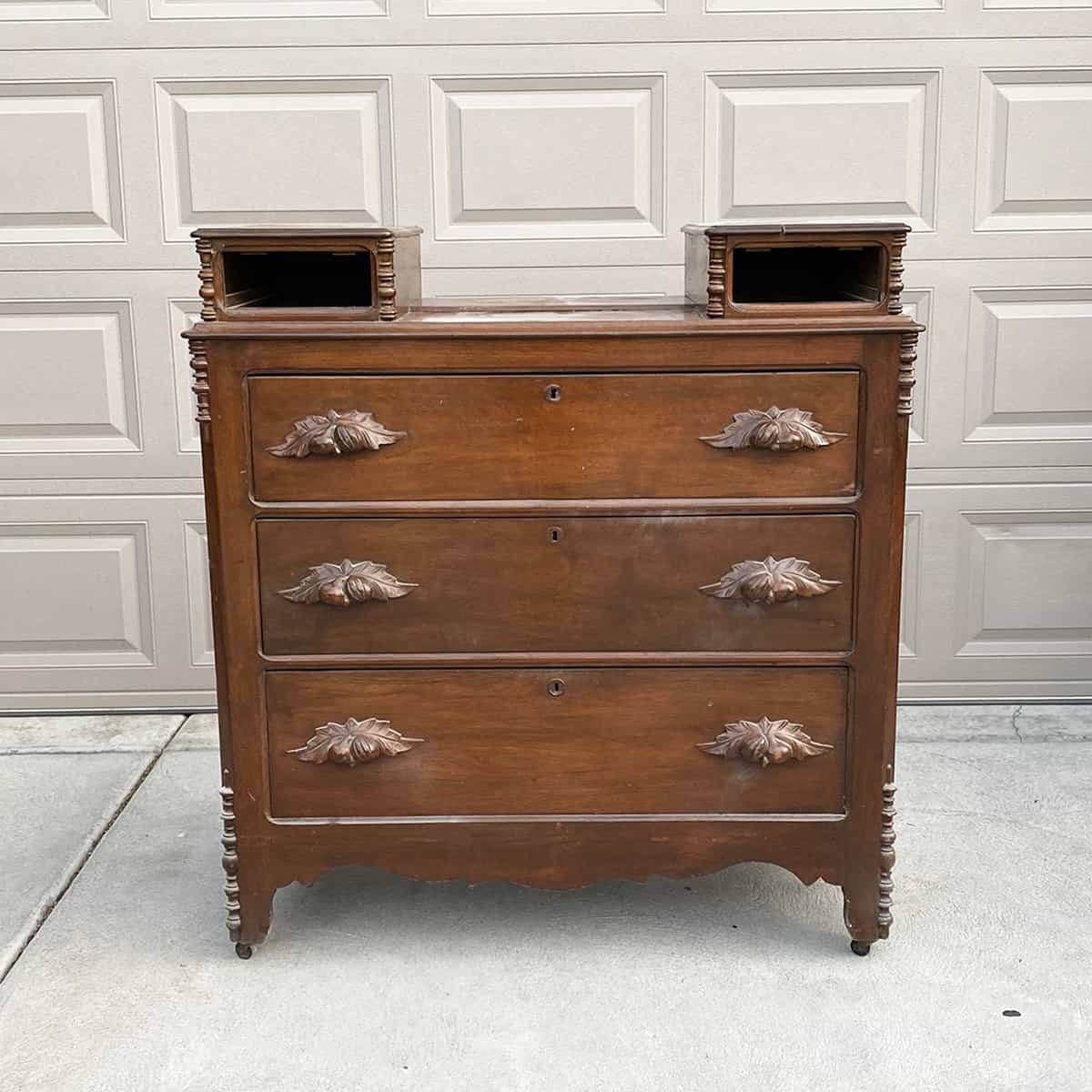
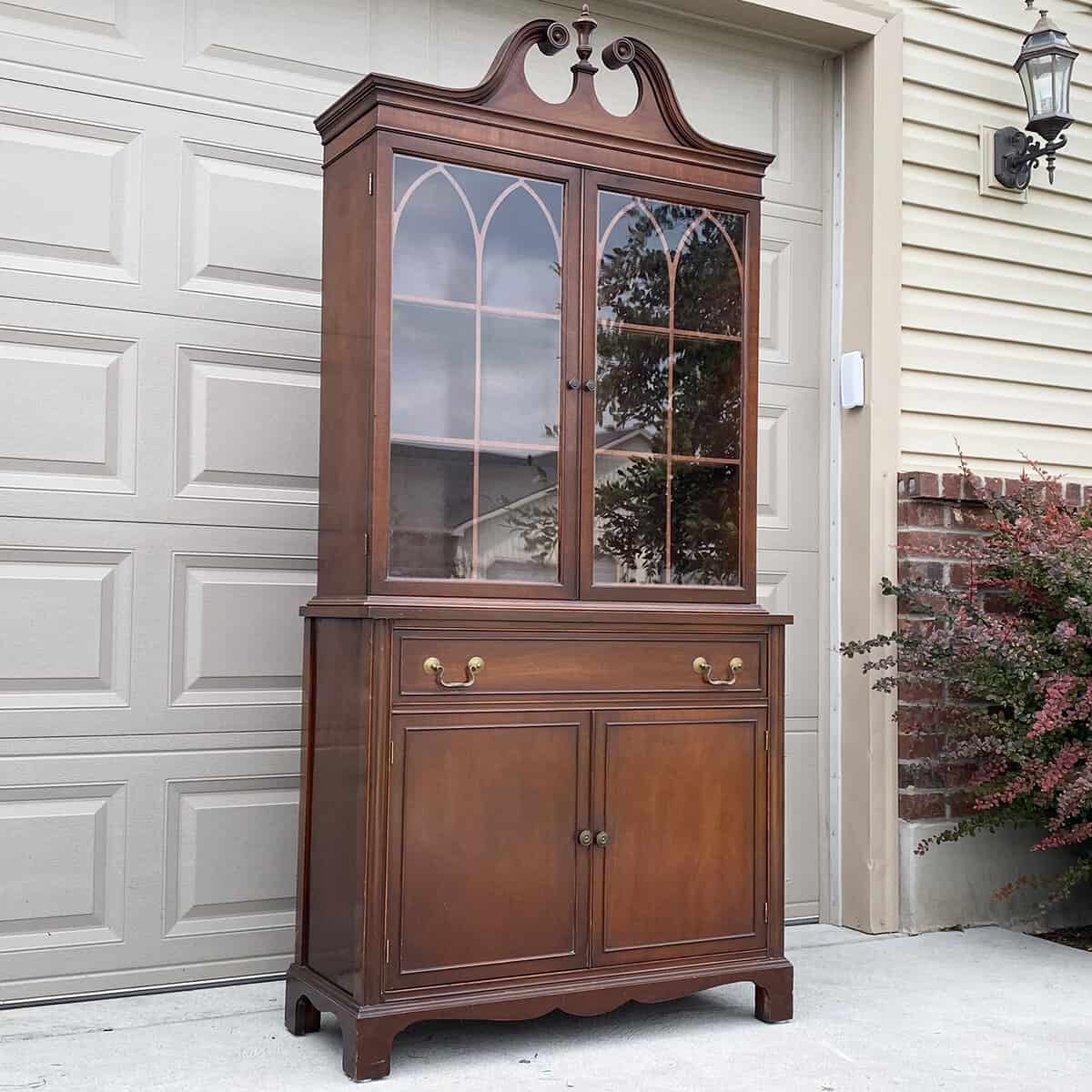
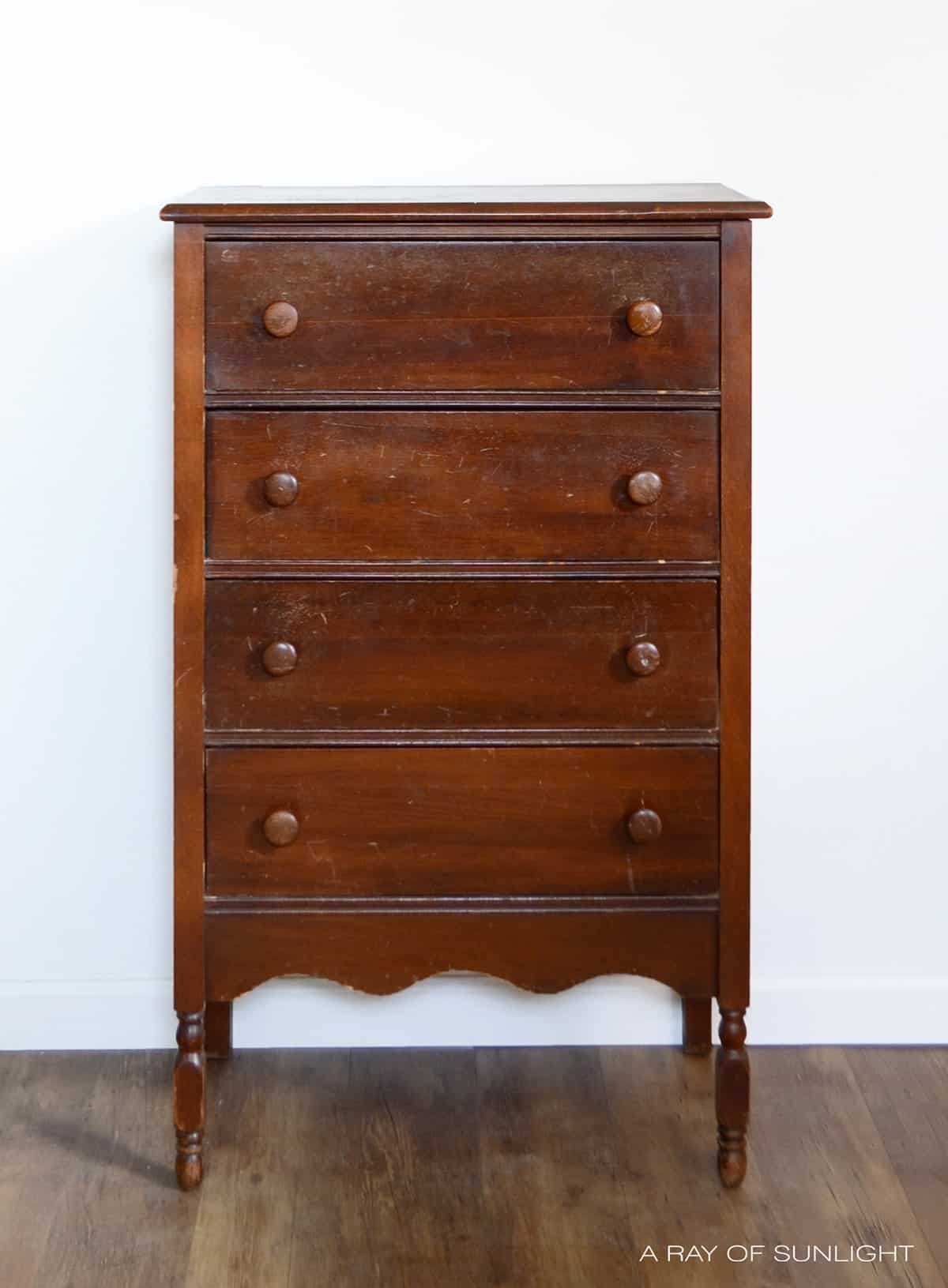
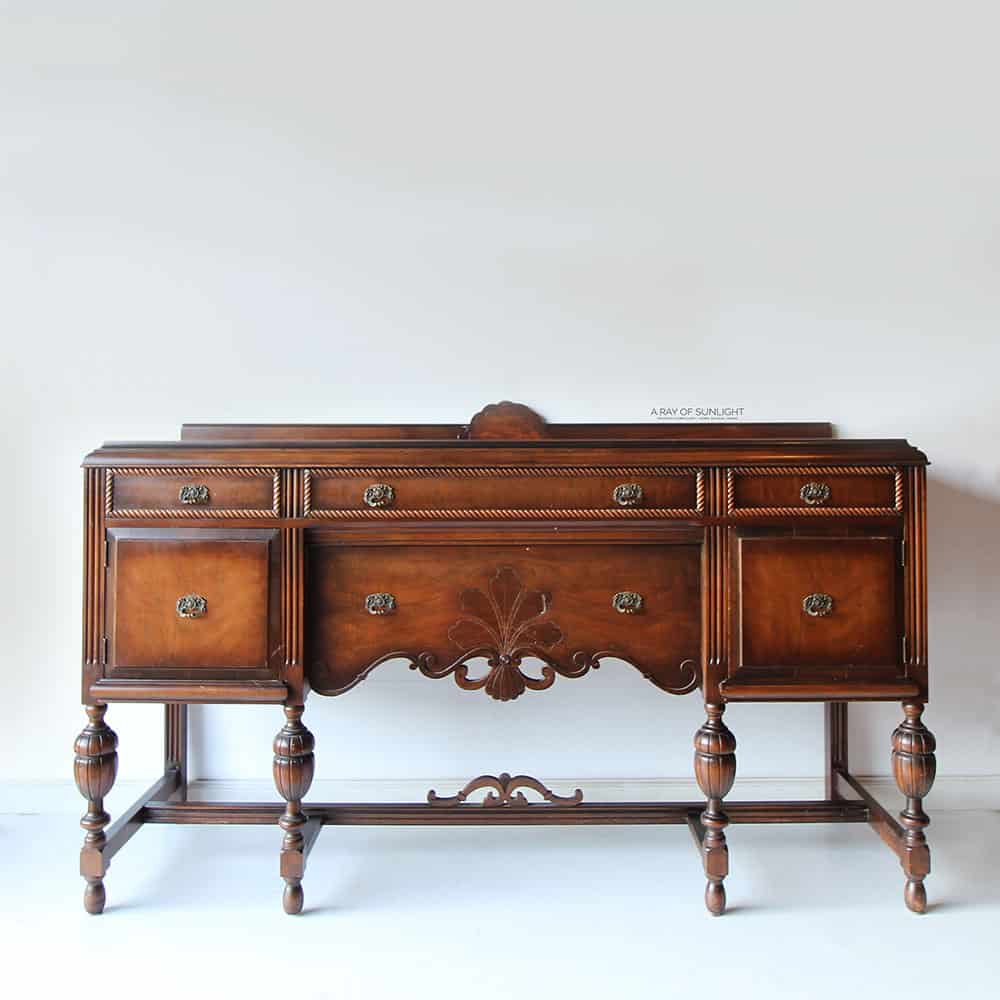
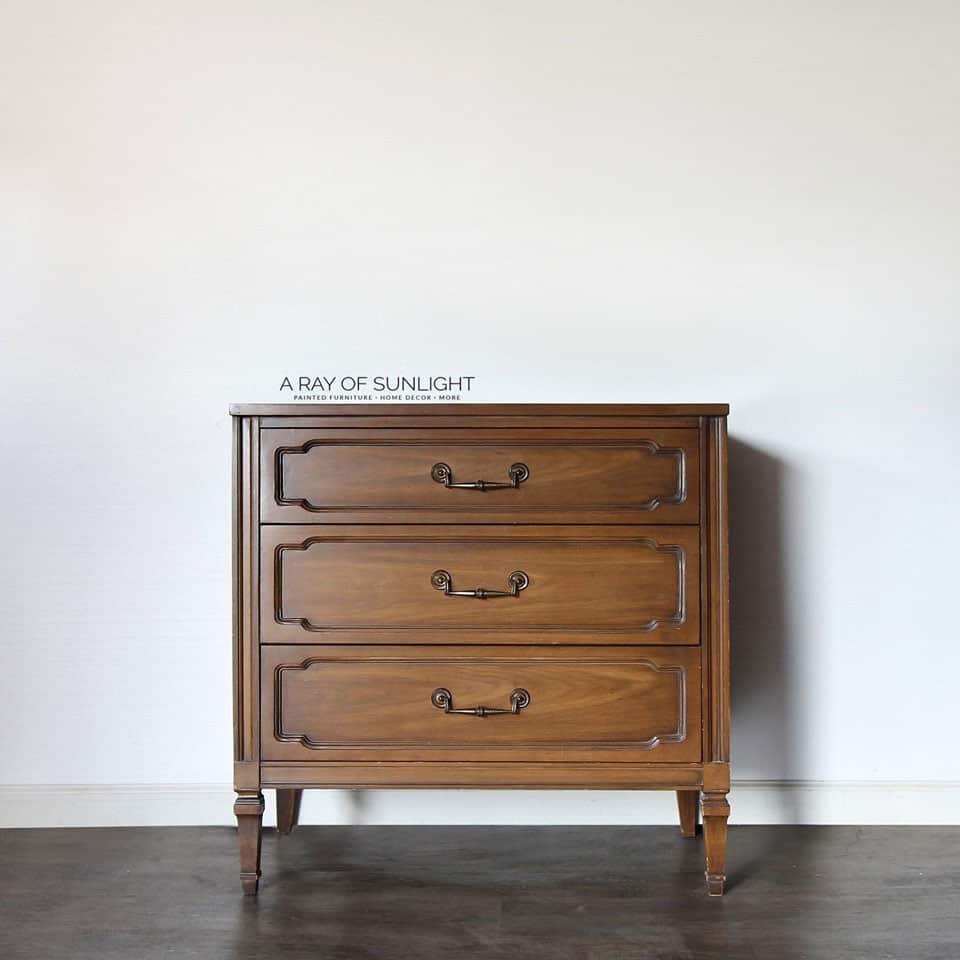
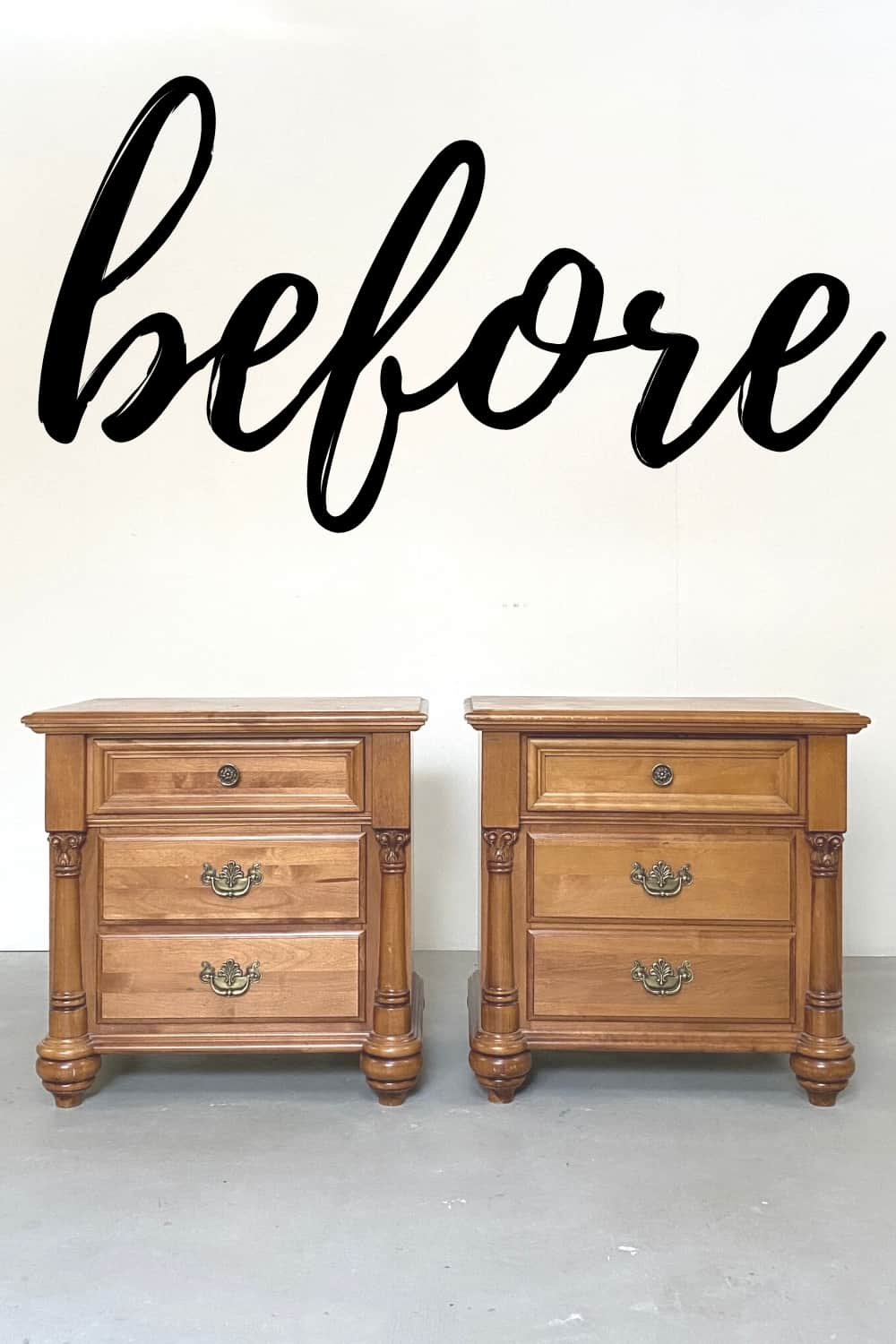
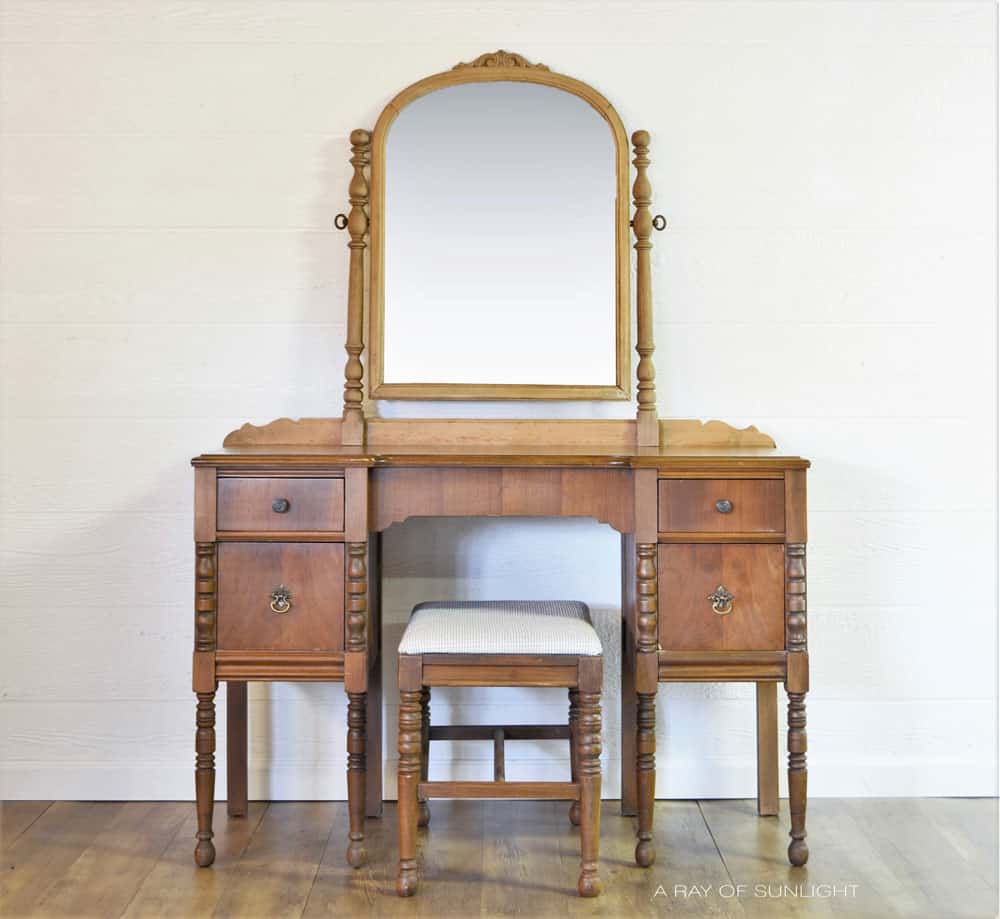
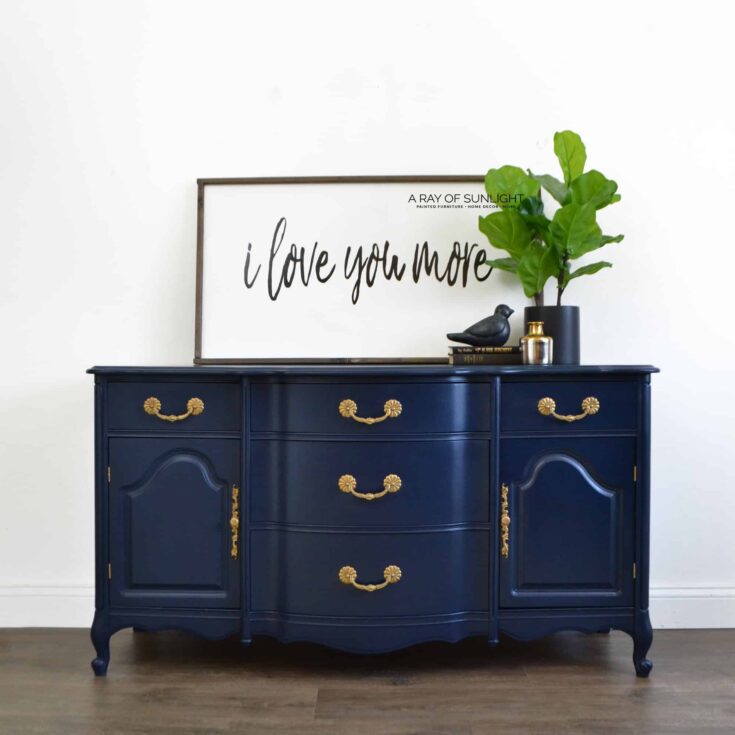



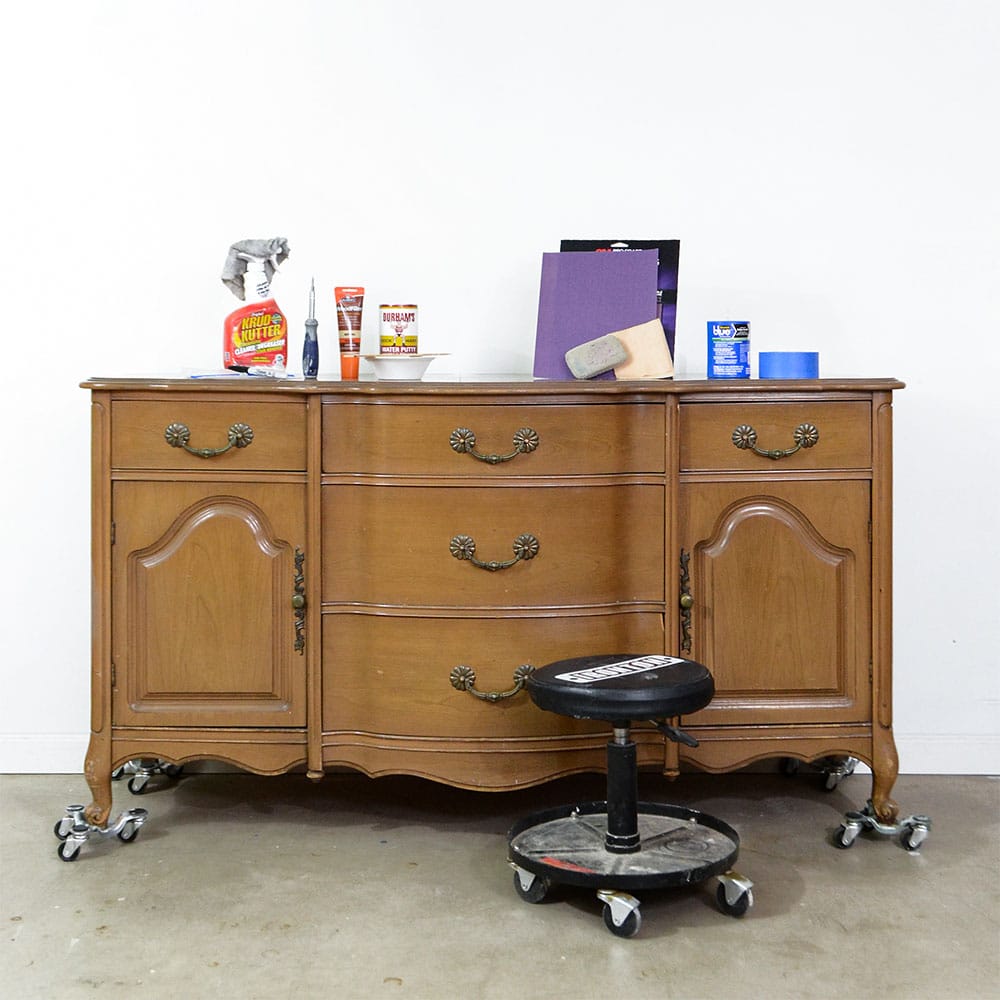
Amazing! This has helped me out so much!
I’ve painted a couple of pieces of furniture and they came out satisfactory. I want to paint 2 dressers and will follow your technique and use your checklist this time as I want them to come out flawless. Wish me luck!
Bin shellac based primer or an oil based primer, or doing both (letting each dry completely before applying the next) should work. Sorry you’re having troubles!
I love how you’ve upcycled this piece of furniture! I recently painted some wardrobe doors in a similar shade and it didn’t go all that well – there are some drip marks and it was hard to cover the white. I don’t think I sanded enough and I didn’t use a primer because it said on the paint pot that it wasn’t needed. In hindsight I wish I’d used some!
Emma